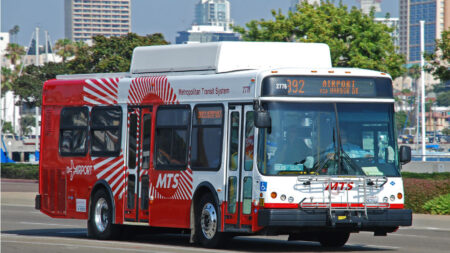One of the best ways for transportation planners to understand the strengths and weaknesses of a public transit system is to experience it for themselves. That’s one reason why I like to ride public transportation wherever I go. On a recent trip to San Diego and Los Angeles, I experienced public transit in a part of the country that is investing billions of dollars in getting people out of their cars and onto buses and trains. Here are a few things I learned from riding buses and trains in and around Southern California.
Prioritize Pedestrians

One evening in Los Angeles, I found myself trying to get from a Gold Line light rail station to a restaurant. The bar was only a quarter-mile from the station, but it was on the other side of a busy six-lane road, with no crosswalks and little street lighting. I had no choice but to jaywalk—as an able-bodied young adult, I could do this— but many people cannot. Another evening, while meeting a friend at a ramen place in San Diego, I got off the bus at the closest stop, a half-mile from my destination, and found myself walking down a narrow, dark sidewalk as cars sped past at 50 miles per hour.
I ride public transit everywhere I go, so I’m used to experiences like these, but that doesn’t make them pleasant and many people won’t tolerate them. You can build the most robust bus network in the world, but if people don’t feel safe and comfortable walking to and from bus stops, they won’t ride the bus. Transit planners and public officials should be prioritizing the pedestrian experience, not just at the station or stop itself, but in the entire area surrounding it.
Frequency Matters, but Network Design Does Too

I spent most of my trip staying with a friend who lives in Irvine, an Orange County suburb, and using commuter rail and Amtrak to get from there to both San Diego and Los Angeles. At no point was I able to use transit to get around. Getting from my friend’s apartment to the train station, the beach, or anywhere else I wanted to go in Orange County, required connections from one infrequent bus to another infrequent bus. If either of those things had been different—if I had been able to take a one-seat trip with no transfers, I could have used it even if it was infrequent, or if I had been able to use two frequent buses with a fast, easy transfer—I would have been able to spend less time in cars and more time on buses.
Dedicated Right of Way or Bust
In a bar on Santa Monica Boulevard one evening, the guy a few stools down from me was talking to the bartender about how he had to get to a dinner at a restaurant six miles away, which at that hour, because of traffic, would take 45 minutes. As a transportation planner, I felt professionally obligated to join the conversation. In the course of talking to him, I told him that I’d been all over LA’s Westside on the bus that day, and he replied, with a look of sheer horror on his face, “Oh my god, why would anyone do that?!”
When your bus, or your streetcar, is sitting in the same traffic as that guy trying to get to his restaurant, there is no way for it to go any faster. If you want to get the people who are complaining about traffic out of their cars, you need to provide a dedicated right of way for your transit vehicles.
A Simple Fare Policy is the Best Fare Policy

One morning, I chose to take the last inbound Metrolink train of the morning to LA. I arrived at the Metrolink station about 15 minutes prior to the train’s arrival, and went to the ticket machines to buy a one-way ticket. The process was straightforward until I got to the end, when a message popped up on the screen telling me that the ticket I was buying was not valid, because the ticket had to be used in the next three hours, and there were no trips between the two stations I had chosen in the next three hours. Confused, I canceled the transaction, double-checked the schedule, and confirmed that there was a train scheduled to arrive at the station I was at within the next ten minutes. I went through the ticket-buying process again, ignored this warning, and had my $10 one-way ticket to LA. The train showed up on time, and I boarded. After all that, no conductor ever checked my ticket, which meant that ticket now would go to waste.
The issue I encountered buying a Metrolink ticket would have dissuaded most people from riding the train. Most people would have simply assumed that they missed the train, and would have chosen a different way to make their trip, or chosen not to take the trip at all. There’s no need for a commuter rail ticket to expire within three hours, either. Make it easy to pay a fare, or you’ll drive away potential riders.
Concluding Thoughts
Southern California, famous for its car culture, has done a remarkable job of expanding its transit network in recent years. The public transit I encountered in both San Diego and Los Angeles provided frequent daytime service and was generally easy to navigate. I look forward to returning in the near future, and hope to encounter a public transit system that is even more robust.
(1) Image from https://laist.com/2019/04/22/la_metro_free_for_earth_day.php
(2) Image from https://timesofsandiego.com/life/2018/01/25/frequency-increased-for-busy-mts-bus-routes-effort-aimed-at-attracting-more-riders/
(3) Image from https://www.govtech.com/fs/Southern-California-Metrolink-Considers-1-5-Million-Safety-Repair.html
Featured photo from https://blog.livelovely.com/2015/04/01/los-angeles-public-transportation/